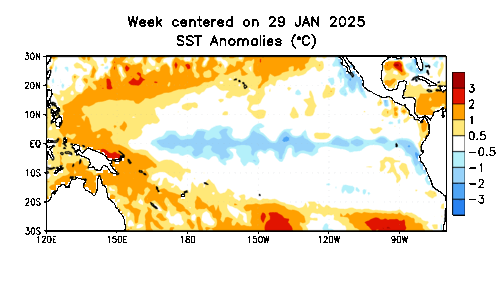
ENSO Update
19 February 2009
Summary
The equatorial Pacific has exhibited weak but clear La Niña conditions since December 2008, and such conditions continue as of mid-February. There is a 55-60% probability of La Niña conditions persisting during the February-April season, decreasing to 30-35% for the April-June season as near-neutral conditions become most likely.
General Discussion
La Niña conditions returned in early December according to the eastern-central Pacific NINO3.4 SST index. Near average conditions had reigned in the tropical Pacific since early June, following the 2007/08 La Niña event. Atmospheric anomalies had suggested that the tropical Pacific should have been cooling since late August 2008, when the Southern Oscillation index became persistently positive, and low-level equatorial winds became persistently easterly. The oceanic response to these atmospheric conditions lagged by three to four months.
Out of a large set of dynamical and statistical forecast models, over half indicate weak La Niña during the coming Feb-Mar-Apr season in progress, but most are trending back towards the neutral range promptly thereafter. Overall, based on model forecasts and current observations of the ocean surface and subsurface, the probability of La Niña conditions is estimated near 60%, of El Niño conditions near 0%, and the probability of maintaining ENSO-neutral conditions is 40% for the Feb-Mar-Apr season in progress. Beginning in Jun-Jul-Aug, no tilt of the climatological odds of 25-50-25% is currently indicated
http://iri.columbia.edu/climate/ENSO/cu ... pdate.html











